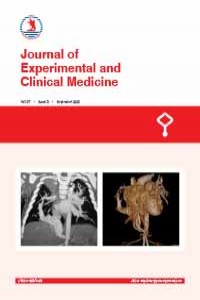Research Article
Year 2020,
Volume: 37 Issue: 3, 67 - 72, 30.04.2020
Abstract
References
- 1. Ross R. The pathogenesis of atherosclerosis: a perspective for the 1990s. Nature 1993; 362: 801-809 2. Carr S, Farb A, Pearce WH, Virmani R. Yao .IS. Atherosclerotic plaque rupture in symptomatic carotid artery stenosis. LJ Vase Surg. 1996;23: 755 -765.
- 3. M. Aleksic, J. Brunkwall: Extracranial Blood Flow Distribution During Carotid Surgery Original Research Article European Journal of Vascular and Endovascular Surgery, Volume 38, Issue 5, November 2009, Pages 552-555
- 4. Joseph P. Archie Jr: The outcome of external carotid endarterectomy during routine carotid endarterectomy, , Original Research Article Journal of Vascular Surgery, Volume 28, Issue 4, October 1998, Pages 585-590
- 5. Enrico Ascer, Mark Gennaro, Robert M. Pollina, Sergio Salles-Cunha, Elka Lorenson, William R. Yorkovich, Micheline Ivanov: The natural history of the external carotid artery after carotid endarterectomy: Implications for management Original Research Article Journal of Vascular Surgery, Volume 23, Issue 4, April 1996, Pages 582-586
- 6. Jenkins MP, Aly S, Sarin S, Adiseshiah M. Patch angioplasty following carotid endarterectomy using the ipsilateral superior thyroid artery. Eur J Vasc Endovasc Surg. 1997 Jul;14(1):60-2.
- 7. Moore WS, Martello JY, Quınones-Baldrich WG, Ahn SS. Etiologic importance of the intimal flap of the external carotid artery in the development of postcarotid endarterectomy stroke. Stroke 1990;21: 1497-50
- 8. P. Belardi, C. Finocchi, G. Lucertini, A. Viacava and G. Simoni. External Carotid Artery Shunting During Carotid endarterectomy An Alternative for Cerebral Protection?: European Journal of Vascular and Endovascular Surgery; Volume 22, Issue 4, October 2001, Pages 306-309
Year 2020,
Volume: 37 Issue: 3, 67 - 72, 30.04.2020
Abstract
In developed countries, atherosclerosis is the major reason for morbidity and mortality. The external carotid artery is an important collateral in atherosclerotic carotid artery disease. Blind endarterectomy is performed to the external carotid artery during carotid endarterectomy surgery. After the surgery performed by this method, a 5-16% occlusion rate in the external carotid artery was reported in the short and long term. The aim is to show the early pathology on the external carotid artery and its clinical importance after standard carotid endarterectomy. In our study, 30 patients who underwent carotid endarterectomy for carotid artery stenosis were recruited in Istanbul University Cerrahpaşa, Department of Cardiovascular Surgery. Twenty-one patients were male and nine females. The mean age was 63.6 (±9.0). Preoperative duplex ultrasonography was performed in all patients. After discharge, during outpatient control FT3, FT4, and TSH were evaluated with blood tests and flow rates with color duplex. Rate evaluation: <50% stenosis if flow rate is <150 cm/s, 50%-75% stenosis if flow rate is between 150-250 cm/s, and >75% stenosis if flow rate is >250 cm/s. In the duplex examination, we did not detect any significant change in flow rates, external carotid artery flow rates in the preoperative and early postoperative period. However, as expected, a significant reduction in the internal carotid artery flow rates after the operation was recorded. In the analysis of thyroid functions, no significant difference was detected between preoperative and postoperative values. Stenosis, occlusion and dissection can be seen on the external carotid artery after carotid endarterectomy. There are no signs or symptoms due to these lesions. Carotid endarterectomy is a safe procedure for external carotid artery and thyroid superior artery and thyroid gland.
Keywords
Atherosclerosis Carotid endarterectomy External Carotid artery velocity Thyroid gland function
References
- 1. Ross R. The pathogenesis of atherosclerosis: a perspective for the 1990s. Nature 1993; 362: 801-809 2. Carr S, Farb A, Pearce WH, Virmani R. Yao .IS. Atherosclerotic plaque rupture in symptomatic carotid artery stenosis. LJ Vase Surg. 1996;23: 755 -765.
- 3. M. Aleksic, J. Brunkwall: Extracranial Blood Flow Distribution During Carotid Surgery Original Research Article European Journal of Vascular and Endovascular Surgery, Volume 38, Issue 5, November 2009, Pages 552-555
- 4. Joseph P. Archie Jr: The outcome of external carotid endarterectomy during routine carotid endarterectomy, , Original Research Article Journal of Vascular Surgery, Volume 28, Issue 4, October 1998, Pages 585-590
- 5. Enrico Ascer, Mark Gennaro, Robert M. Pollina, Sergio Salles-Cunha, Elka Lorenson, William R. Yorkovich, Micheline Ivanov: The natural history of the external carotid artery after carotid endarterectomy: Implications for management Original Research Article Journal of Vascular Surgery, Volume 23, Issue 4, April 1996, Pages 582-586
- 6. Jenkins MP, Aly S, Sarin S, Adiseshiah M. Patch angioplasty following carotid endarterectomy using the ipsilateral superior thyroid artery. Eur J Vasc Endovasc Surg. 1997 Jul;14(1):60-2.
- 7. Moore WS, Martello JY, Quınones-Baldrich WG, Ahn SS. Etiologic importance of the intimal flap of the external carotid artery in the development of postcarotid endarterectomy stroke. Stroke 1990;21: 1497-50
- 8. P. Belardi, C. Finocchi, G. Lucertini, A. Viacava and G. Simoni. External Carotid Artery Shunting During Carotid endarterectomy An Alternative for Cerebral Protection?: European Journal of Vascular and Endovascular Surgery; Volume 22, Issue 4, October 2001, Pages 306-309
There are 7 citations in total.
Details
| Primary Language | English |
|---|---|
| Subjects | Health Care Administration |
| Journal Section | Clinical Research |
| Authors | |
| Publication Date | April 30, 2020 |
| Submission Date | December 1, 2019 |
| Acceptance Date | March 11, 2020 |
| Published in Issue | Year 2020 Volume: 37 Issue: 3 |
Cite

This work is licensed under a Creative Commons Attribution-NonCommercial 4.0 International License.


